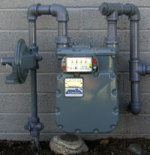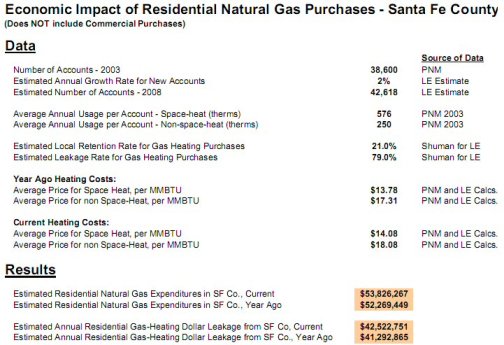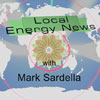Wednesday
Mar122008
As Natural Gas Costs Rise, Dollar Leakage Worsens
 Mar 12, 2008 at 09:50PM
Mar 12, 2008 at 09:50PM  The amount of money leaking out of communities to pay for natural gas is rising as the price of natural gas rises. Even little Santa Fe County, New Mexico, with about 42,000 residential gas accounts, now loses more than $40 million annually as residents purchase the non-local heating fuel. Numbers from the analysis done by Local Energy are shown below, and a flyer for distributing the data can be downloaded here. I'll work on getting commercial numbers too.
The amount of money leaking out of communities to pay for natural gas is rising as the price of natural gas rises. Even little Santa Fe County, New Mexico, with about 42,000 residential gas accounts, now loses more than $40 million annually as residents purchase the non-local heating fuel. Numbers from the analysis done by Local Energy are shown below, and a flyer for distributing the data can be downloaded here. I'll work on getting commercial numbers too.








Questions and Answers on Feed-In Tariffs
QUESTION: Who measures the kWh produced and pays out the appropriate feed in tariff amounts earned to the multiplicity of green producers? Who collects the money from other utility customers which are redistributed via feed-in tariff payments? Finally, is there any regulatory oversight?
MS: I believe the prevailing practice in Europe is to task the utilities with reading the meters and making tariff payments. Utilities are, after all, the ones signing the 20-year power purchase agreements at the tariff rate. Utilities are also responsible for billing and collecting the monthly charges that fund the tariff payments. Paying generators for kilowatt-hours and adding surcharges to bills are things that utilities do in their normal course of business anyway, so the regulatory oversight of these activities under a feed-in law isn’t really an added burden.
I can think of several ways to improve on the European tariff model. First, the funding to cover tariff payments should not be collected using throughput-based surcharges on utility bills unless it can be done in a way that isn’t economically regressive. Given the widespread economic benefits that result from the tariff, there may be a good case for collecting the revenues for it via the tax base rather than the rate base.
Second, the tariff rate offered should be based on the locational strategic value of the generator to the grid. If it’s downstream of a bottleneck such that it frees up needed capacity and delays or obviates a line upgrade, it’s worth more. At the end of a long feeder that sags under load, or in a place that needs VAR support, it’s worth a lot more. The Electric Power Research Institute has software models and reports showing how to assess the value of strategically placed resources.
Finally, the tariff should be used to meet other objectives, rather than just being a tool to promote renewable energy. This can be done by setting qualifying standards for the tariff program. For instance, the tariff language could require that each generator be owned within the community where it is located, which would increase local retention of energy dollars. As another example, biomass generators could be required to have an independent certification showing that the wood was sustainably harvested. The possibilities are endless.
Click to read more ...